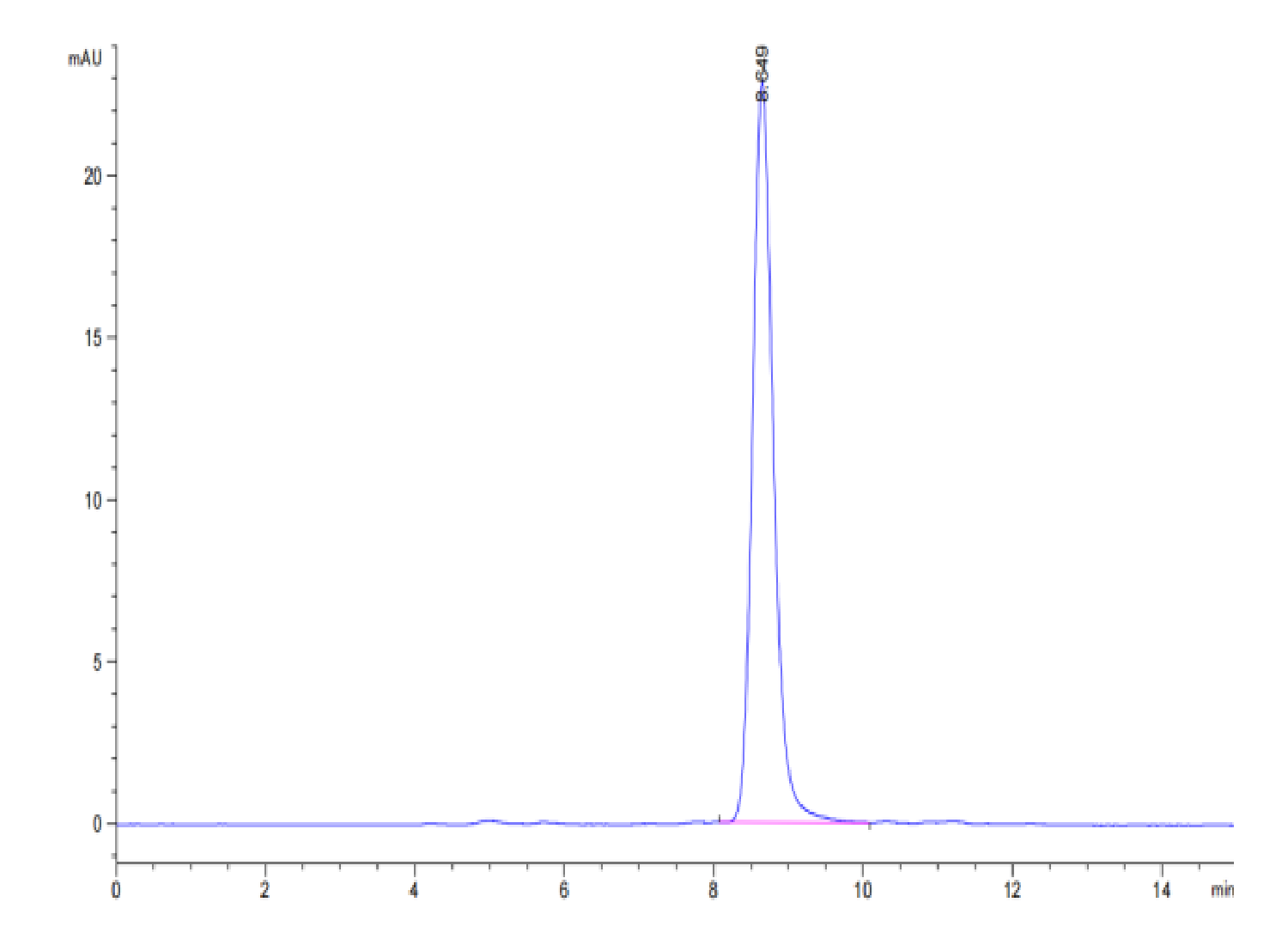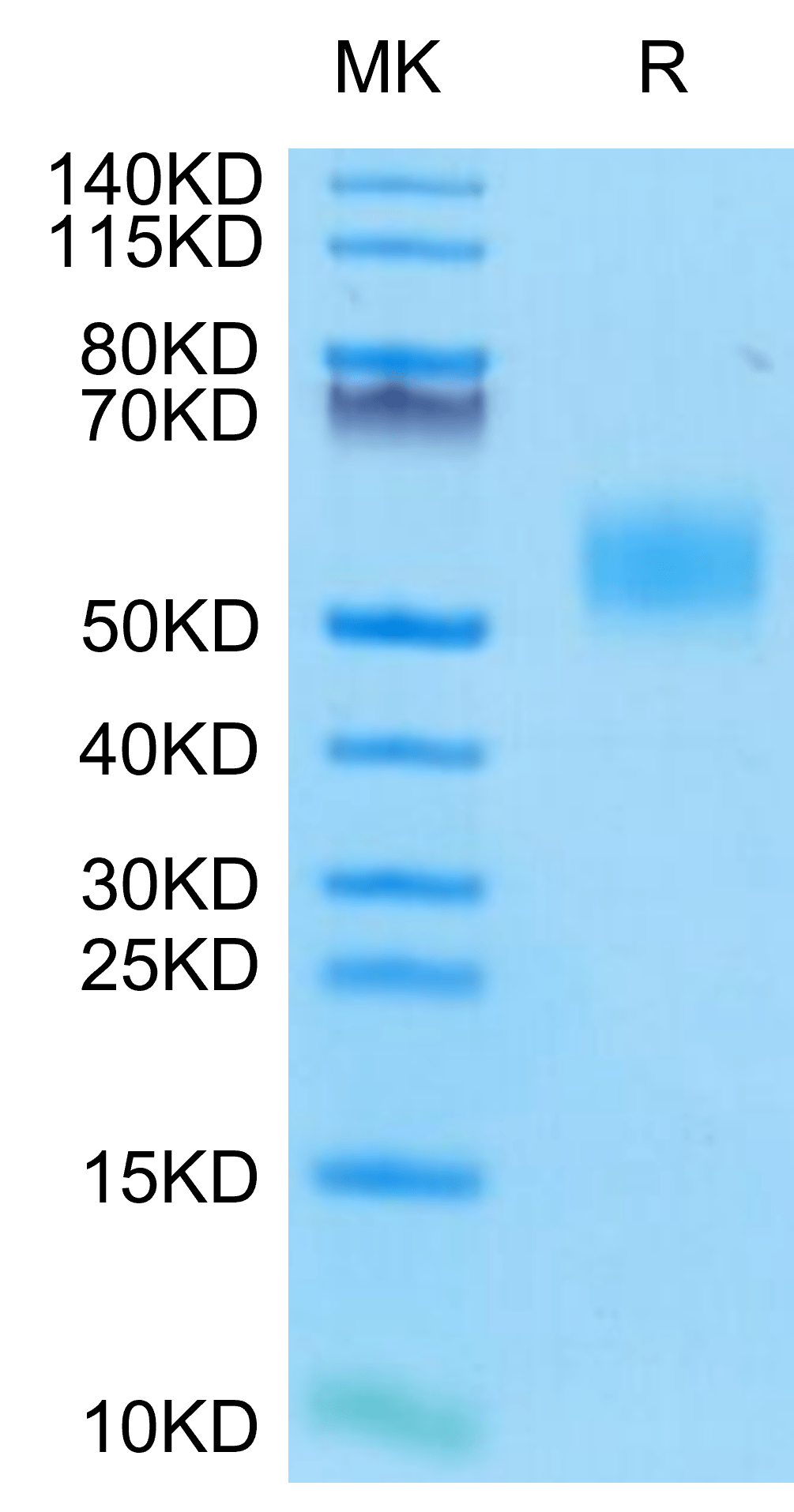| Weight | 1 lbs |
|---|---|
| Dimensions | 9 × 5 × 2 in |
| accession | NP_033971 |
| express system | HEK293 |
| product tag | C-His |
| purity | > 95% as determined by Tris-Bis PAGE;> 95% as determined by HPLC |
| background | CD14 is a glycosylphosphatidylinositol (GPI)-anchored receptor known to serve as a co-receptor for several Toll-like Receptors (TLRs) both at the cell surface and in the endosomal compartment. CD14 can be expressed by cells of both hematopoietic and non-hematopoietic origin as a cell membrane or secreted protein. |
| molecular weight | The protein has a predicted MW of 38.19 kDa. Due to glycosylation, the protein migrates to 52-62 kDa based on Tris-Bis PAGE result. |
| available size | 100 µg, 500 µg |
| endotoxin | Less than 1EU per μg by the LAL method. |
Mouse CD14 Protein 2871
$300.00 – $1,000.00
Summary
- Expression: HEK293
- Pure: Yes (HPLC)
- Amino Acid Range: Ser16-Pro345
Mouse CD14 Protein 2871
| protein |
|---|
| Size and concentration 100, 500µg and lyophilized |
| Form Lyophilized |
| Storage Instructions Valid for 12 months from date of receipt when stored at -80°C. Recommend to aliquot the protein into smaller quantities for optimal storage. Please minimize freeze-thaw cycles. |
| Storage buffer Shipped at ambient temperature. |
| Purity > 95% as determined by Tris-Bis PAGE |
| target relevance |
|---|
| CD14 is a glycosylphosphatidylinositol (GPI)-anchored receptor known to serve as a co-receptor for several Toll-like Receptors (TLRs) both at the cell surface and in the endosomal compartment. CD14 can be expressed by cells of both hematopoietic and non-hematopoietic origin as a cell membrane or secreted protein. |
| Protein names Monocyte differentiation antigen CD14 (My23 antigen) (Myeloid cell-specific leucine-rich glycoprotein) (CD antigen CD14) [Cleaved into: Monocyte differentiation antigen CD14, urinary form; Monocyte differentiation antigen CD14, membrane-bound form] |
| Mass 40076Da |
| Function Coreceptor for bacterial lipopolysaccharide (PubMed:1698311, PubMed:23264655). In concert with LBP, binds to monomeric lipopolysaccharide and delivers it to the LY96/TLR4 complex, thereby mediating the innate immune response to bacterial lipopolysaccharide (LPS) (PubMed:20133493, PubMed:22265692, PubMed:23264655). Acts via MyD88, TIRAP and TRAF6, leading to NF-kappa-B activation, cytokine secretion and the inflammatory response (PubMed:8612135). Acts as a coreceptor for TLR2:TLR6 heterodimer in response to diacylated lipopeptides and for TLR2:TLR1 heterodimer in response to triacylated lipopeptides, these clusters trigger signaling from the cell surface and subsequently are targeted to the Golgi in a lipid-raft dependent pathway (PubMed:16880211). Binds electronegative LDL (LDL(-)) and mediates the cytokine release induced by LDL(-) (PubMed:23880187). {ECO:0000269|PubMed:16880211, ECO:0000269|PubMed:1698311, ECO:0000269|PubMed:20133493, ECO:0000269|PubMed:22265692, ECO:0000269|PubMed:23264655, ECO:0000269|PubMed:23880187, ECO:0000269|PubMed:8612135}. |
| Subellular location Cell membrane {ECO:0000269|PubMed:1698311, ECO:0000269|PubMed:2462937, ECO:0000269|PubMed:3385210}; Lipid-anchor, GPI-anchor {ECO:0000269|PubMed:1698311, ECO:0000269|PubMed:2462937, ECO:0000269|PubMed:3385210}. Secreted {ECO:0000269|PubMed:25497142, ECO:0000269|PubMed:2779588}. Membrane raft {ECO:0000269|PubMed:16880211}. Golgi apparatus {ECO:0000269|PubMed:16880211}. Note=Secreted forms may arise by cleavage of the GPI anchor. {ECO:0000269|PubMed:2462937, ECO:0000269|PubMed:2779588, ECO:0000269|PubMed:3385210}. |
| Tissues Detected on macrophages (at protein level) (PubMed:1698311). Expressed strongly on the surface of monocytes and weakly on the surface of granulocytes; also expressed by most tissue macrophages. {ECO:0000269|PubMed:1698311, ECO:0000269|PubMed:25497142}. |
| Structure Interacts with LPS-bound LPB (PubMed:1698311, PubMed:23264655). Belongs to the lipopolysaccharide (LPS) receptor, a multi-protein complex containing at least CD14, LY96 and TLR4 (PubMed:11274165). Interacts with LPAR1 (By similarity). Interacts with the TLR2:TLR6 or TLR2:TLR1 heterodimers; upon interaction with ligands such as diacylated lipopeptides and triacylated lipopeptides, respectively (PubMed:16880211). Interacts with MYO18A (PubMed:25965346). Interacts with FSTL1 (PubMed:22265692). {ECO:0000250|UniProtKB:P10810, ECO:0000269|PubMed:11274165, ECO:0000269|PubMed:16880211, ECO:0000269|PubMed:1698311, ECO:0000269|PubMed:22265692, ECO:0000269|PubMed:23264655, ECO:0000269|PubMed:25965346}. |
| Post-translational modification N- and O- glycosylated. O-glycosylated with a core 1 or possibly core 8 glycan. {ECO:0000269|PubMed:16335952, ECO:0000269|PubMed:19159218, ECO:0000269|PubMed:19838169}. |
| Domain The C-terminal leucine-rich repeat (LRR) region is required for responses to smooth LPS. {EC |
| Target Relevance information above includes information from UniProt accession: P08571 |
| The UniProt Consortium |
Data
 |
| The purity of Mouse CD14 is greater than 95% as determined by SEC-HPLC. |
 |
| Mouse CD14 on Tris-Bis PAGE under reduced condition. The purity is greater than 95%. |
Publications
Publications
| pmid | title | authors | citation |
|---|---|---|---|
| We haven't added any publications to our database yet. | |||
Protocols
| relevant to this product |
|---|
Documents
| # | ||
|---|---|---|
| Please enter your product and batch number here to retrieve product datasheet, SDS, and QC information. | ||














